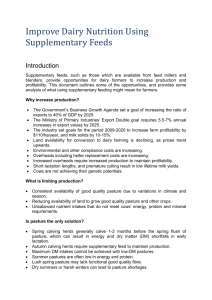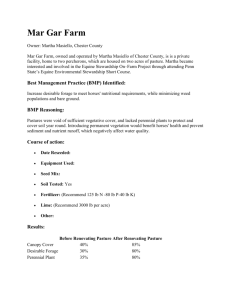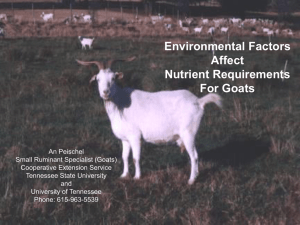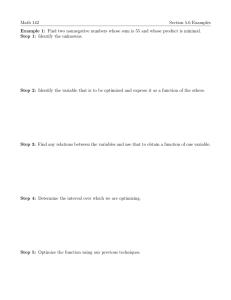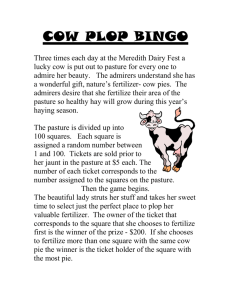Wm. A. Schoenfeld, Director Circular of Information No, 310 ON
advertisement
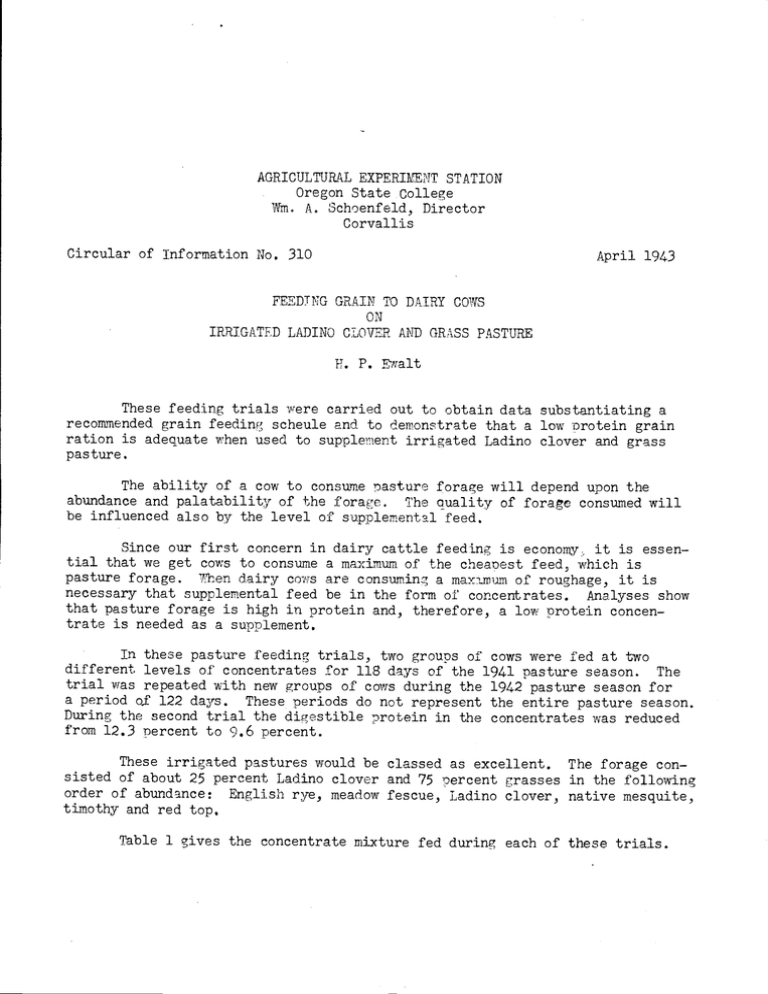
AGRICULTURfJJ EXPERThENT STATION Oregon State College Wm. A. Schoenfeld, Director Corvallis Circular of Information No, 310 April 1943 FEEDING GRAIN TO DAIRY COWS ON IRRIGATED LADINO CLOVER AND GRASS PASTURE F. P. Ewalt These feeding trials were carried out to obtain data substantiating a recommended grain feeding scheule and to demonstrate that a low protein grain ration is adequate when used to supplement irrigated Ladino clover and grass pasture. The ability of a cow to consume pasture forage will depend upon the abundance and palatability of the forage. The auality of foragc consumed will be influenced also by the level of supplemental feed. Since our first concern in dairy cattle feeding is economy, it is essential that we get cows to consume a maximum of the cheapest feed, which is pasture forage. 1then dairy cows are consuming a maximum of roughage, it is necessary that supplemental feed be in the form of concentrates. Analyses show that pasture forage is high in protein and, therefore, a low protein concentrate is needed as a supplement. In these pasture feeding trials, two groups of cows were fed at "vo different levels of concentrates for 118 days of the 1941 pasture season. The trial was repeated with new groups of cows during the 1942 pasture season for a period o1 122 days. These periods do not represent the entire pasture season. During the second trial the digestible protein in the concentrates was reduced from 12.3 percent to 9.6 percent. These irrigated pastures would be classed as excellent. The forage consisted of about 25 percent Ladino clover and 75 percent grasses in the following order of abundance: English rye, meadow fescue, Ladino clover, native mesquite, timothy and red top. Table 1 gives the concentrate mixture fed during each of these trials. 2 Table 1 Concentrate Mixtures First Trial 1941 pounds Second Trial 1942 pounds 240 400 200 200 180 400 Bran Oats Barley Linseed meal Wheat Coconut meal Salt Bone flour Digestible protein (percent) 300 100 10 10 9.6 22 22 12.3 These concentrate mixtures were made up on the basis of the price of each ingredient. During the second trial the amount of salt and bone flour was reduced from 2 to 1 percent of the mix. The mix for the first trial contained 12.3 percent digestible protein. The mix for the second trial contained 9.6 percent digestible protein. These groups of cows were evenly matched as to age, weight, stage of lactation and gestation except for age in the second trial where group one was 9 months younger than group two. Table at different year but not 1 year and 9 younger than 2 gives the average-per-cow daily data on the four groups of cows levels of concentrate feeding. The groups are comparable each one year against the other. In 1942 the cows in group one were months younger than group one in 1941, and group two was 7 months the group two in 1941. Table 2 Average Production and Feed Re4rement Per Cow Da Year Groups 4% milk, pound Concentrates, pound *T,D.N. required T.D.N. fed (concentrates) T,D.. fed (silage) T,D.N. fed in barn T.D.N. from pasture, lbs. T,D.N. from pasture, % Ratio of conc. to4% milk 1941 1 41.99 8.41 22.85 5.96 -5.96 16.38 73.9 U5,0 1942 2 42.15 11.64 23.43 8.25 -8.25 15.18 64.8 1:3,6 Groups 2 Yr. Ave. 1 2 1 2 33.94 36.93 11.68 23.90 8.58 37.96 39.54 11.67 8.25 22.25 6.10 .58 6.68 15.57 69.9 1:4,1 .58 9.16 14.74 61.7 1:3.2 0.33 22.54 6.03 .58 6.32 16.22 72.0 1:4.5 * Total digestible nutrients. ** Grass silage was fed only during the last month of the second trial. 23.66 8.41 8.70 14.86 62.8 13.4 3 A study of Table 2 brings out the following points: 1. raking a correction for difference in age between the groups in different years the production of both groups is equal. Therefore the mix with 9.6% digestible protein the second year was equal to the concentrate mix with 12.3% digestible protein the first year. 2. Group 1 each year did not gain as regularly in weight as did group 2; therefore, under good management a trifle more grain should have been fed. 3. Group 2 gained a trifle more than desirable in weight and consumed less cheap forage which they could have eaten as well as group 1. Therefore their rate of grain feeding was high. 4. The correct level of feeding which is halfway between the average for the two years on both groups is the same as that recommended in Oregon Extension Bulletin 592 and in Oregon Station Bulletin 398. Table 3 Average Daily Production Per Cow on Two Levels of Protein Age (years and months) Stage of lactation (days) Initial weight Final weight Gain, pounds Concentrates, pounds Ji1k, pounds irilk 4%, pounds Calculated dig. pro, in concentrates, percent 1941 1942 4.4 5,5 80 1195 95 1143 1178 35 12.5 52.1 46.1 12.3 1232 37 14.9 58.8 51.7 9.6 These cors grazed on the same pasture each year. The forage was possibly a little more abundant during 1942 than in 1941. During 1941 there was ample forage to enable the cows to graze to the limit of their capacity or desire. it is evident from these data that 9.6 percent digestible protein in the concentrates was adequate for maximum milk production. 4 Table 4 Schedule of Concentrate Feedp to Cows on Excellent, Good, and Fair Irrigated Pastures 3.0 Percent 16,5 19.0 22.0 24.5 27.0 Pounds milk Produced Daily 4.0 5.0 Percent Percent 14.0 16.0 18,5 21.0 23.0 25.5 27.5 30.0 32.5 30,0 32.5 35.5 38.0 41,0 43.5 46.0 49.0 52.0 54,5 57.0 34.5 37.0 39,0 41.5 44.0 46.0 48.5 50.5 53.0 55.0 60,0 62.5 65.5 12.0 14.0 16.0 18.0 20.0 22,0 24,0 26.0 28.0 30.0 32.0 34.0 36.0 38.0 40.0 42.0 44.0 46,0 48.0 6.0 Percent 10.5 12.0 14.0 16.0 Amount of Concentrate to Feed Daily With With With Excellent Good Fair Pasture Pasture Pasture None None None 1 2 None 1 4 4 6 7 8 3 5 4 23.0 5 24.5 26.5 6 7 6 7 8 28.0 30.0 32.0 8 9 10 11 12 13 10 11 12 13 14 14 16* 17* 18* 41.0 15 42.5 16* 3 2 3 17.5 19.5 21.0 33.5 35.5 37.5 39.0 2 9 15 5 9 10 11 12 13 14 15 16* 17* 18* 19* 20* * No more concentrates should be fed than the cow can eat and digest without going off feed regardless of the amount required to maintain production. Summary 1. then grazing on irrigated Ladino clover and grass pasture, 1100 to 1200-pound cows may obtain 65 to 75 percent of their necessary nutrients from pasture when producing approximately 40 pounds of 4 percent milk daily or 1.6 pounds of butterfat daily. 2. on the basis of T.D.N. required, the 16 cows used in these trials grazed an average of 115 pounds of forage daily. 3. An average of two trials in two successive years indicates that concentrates fed at the ratio of 1 pound of concentrates to 4.5 pounds of 4 percent milk was not quite equal to a ratio of 1:3.4 of 4 percent milk when the cows were on excellent pasture and producing 38 to 40 pounds of 4 percent milk daily. A ratio of 1:4.0 would be the correct level under the conditions given. 5 4. The production of milk on ccncentrates containing 9.6 percent digestible protein was equal to the production when the concentrates contained 12.3 percent diRestible protein, all other conditions being equal. 5, Cows should be fed individually on the basis of production. The level of grain feeding should be kept as near as possible to that recommended in Table 4.


